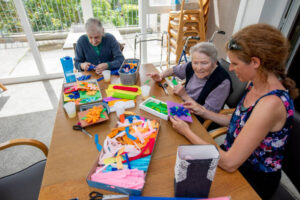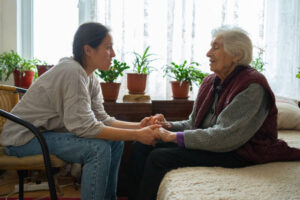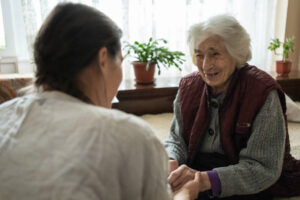Understanding Memory Care Programs
When it comes to caring for individuals with Alzheimer’s disease and other forms of dementia, memory care programs play a vital role in providing specialized care and support. Let’s explore what memory care programs are and the benefits they offer.
What Are Memory Care Programs?
Memory care programs are specifically designed to cater to the unique needs of individuals with memory impairments, such as Alzheimer’s and dementia. These programs provide a safe and secure environment where residents receive 24-hour supervised care from specialized staff who are trained to address the challenges and behaviors associated with memory loss.
In memory care programs, the physical layout and design of the facility are tailored to support the needs of residents. This may include color-coded hallways, memory boxes outside residents’ rooms, and other features that help stimulate memory and assist residents in navigating their surroundings independently.
Benefits of Memory Care Programs
Memory care programs offer a range of benefits that can greatly enhance the quality of life for individuals with memory impairments. Here are some key advantages:
- Specialized Care: Memory care programs provide specialized care that focuses on meeting the unique needs of individuals with memory loss. The staff is trained to understand and manage the challenges associated with dementia, ensuring that residents receive the appropriate level of care and support.
- Structured Routines and Activities: Memory care programs typically offer structured routines and engaging activities tailored to help residents cope with memory loss and maintain their cognitive abilities. These activities can include cognitive stimulation exercises, sensory stimulation activities, and opportunities for socialization and engagement. The goal is to enhance cognitive function, promote well-being, and reduce feelings of isolation.
- Secure and Dementia-Friendly Environment: Memory care programs provide a secure environment that is specifically designed to meet the safety needs of individuals with memory impairments. The facilities are equipped with features such as secure entrances, alarmed doors, and monitoring systems to prevent wandering and ensure the safety of residents. This allows family members to have peace of mind knowing their loved ones are in a secure setting.
- Personalized Care Plans: Memory care programs create personalized care plans for each resident, taking into account their unique needs and preferences. These care plans address not only the physical care requirements but also the emotional and social well-being of the residents. By tailoring the care to individual needs, memory care programs can provide a higher level of support and improve the overall quality of life for residents.
Memory care programs offer a comprehensive approach to caring for individuals with memory impairments. Through specialized care, engaging activities, and a secure environment, these programs aim to enhance the well-being and cognitive function of residents, while providing peace of mind to their families.
Features of Memory Care Programs
Memory care programs are specifically designed to provide specialized care and support for individuals with memory impairments, such as Alzheimer’s disease or dementia. These programs offer a range of features and services that cater to the unique needs of seniors with memory loss. Let’s explore some of the key features of memory care programs.
Specially Trained Staff
Memory care programs are staffed by professionals who have received specialized training in caring for individuals with memory impairments. They possess the knowledge and expertise to understand the unique challenges faced by seniors with memory loss and provide the necessary support and assistance.
The staff members in memory care programs are trained to communicate effectively and compassionately with residents, understanding their individual needs and preferences. They are skilled in managing behaviors associated with memory loss and have a deep understanding of Alzheimer’s disease and dementia.
Secure and Dementia-Friendly Environment
Memory care programs prioritize the safety and well-being of their residents. These programs often feature a secure and dementia-friendly environment to prevent residents from wandering and ensure their safety. Measures such as secured entries and exits, as well as a secure outdoor space, are implemented to provide a secure living environment.
In addition to security measures, memory care environments incorporate design elements that promote independence and stimulate memory. Color-coded hallways, memory boxes outside residents’ rooms, and other visual cues help individuals navigate their surroundings and trigger memory recall.
Structured Routines and Activities
Structured routines and activities play a crucial role in memory care programs. These programs provide residents with a predictable and consistent daily schedule, which can help reduce anxiety and confusion associated with memory loss. Regular routines provide a sense of stability and familiarity, promoting a better quality of life for seniors with memory impairments.
Memory care programs also offer a variety of activities that are tailored to stimulate cognitive function and provide meaningful engagement. These activities may include brain games, puzzles, art therapy, music therapy, and exercise classes. Engaging in such activities can help maintain cognitive abilities, improve mood, and enhance overall well-being.
By providing specially trained staff, a secure environment, and structured routines and activities, memory care programs offer comprehensive support and care for seniors with memory impairments. These programs aim to enhance the overall quality of life for individuals with memory loss, fostering a safe and engaging living environment.
The Role of Memory Care Programs
Memory care programs play a vital role in supporting individuals experiencing memory loss, Alzheimer’s, or other forms of dementia. These programs provide specialized care and activities tailored to meet the unique needs of seniors with cognitive impairments. Let’s explore the key roles that memory care programs play in enhancing the lives of individuals in their care.
Providing Personalized Care Plans
Memory care programs are designed to provide individualized care plans for each resident. These care plans are developed based on a thorough assessment of the resident’s cognitive abilities, personal preferences, and medical history. By understanding the specific needs of each individual, memory care programs can create a tailored approach to care, focusing on promoting independence, maintaining dignity, and ensuring overall well-being.
Enhancing Cognitive Function and Well-Being
Participation in memory care programs can have a significant impact on enhancing cognitive function and overall well-being. These programs offer a range of activities, including cognitive stimulation exercises, memory games, and puzzles, aimed at keeping the mind active and engaged. According to research cited by A Place for Mom, engaging in such activities can lead to increased cognitive abilities, improved mood, decreased agitation, and reduced medication use in seniors with dementia.
Reducing Wandering and Improving Safety
One of the primary concerns for individuals with dementia is wandering, which can pose risks to their safety. Memory care programs address this concern by providing a secure and dementia-friendly environment. These programs incorporate additional security measures, such as secured outdoor spaces and restricted access, to prevent residents from wandering off. By creating a safe and controlled environment, memory care programs help minimize the risk of falls, injuries, and disorientation that can result from wandering.
In addition to the secure environment, memory care programs also offer 24-hour supervised care from specialized staff who are trained to deal with the challenges and behaviors associated with dementia. This constant support and supervision ensure that residents receive the assistance they need, fostering their safety and well-being.
Memory care programs play a crucial role in providing the necessary support and specialized care for individuals with memory impairments. Through personalized care plans, cognitive stimulation activities, and a secure environment, these programs help enhance the quality of life for seniors with dementia. By valuing the unique needs of each resident, memory care programs empower individuals to maintain their independence, preserve their dignity, and experience a sense of purpose and fulfillment.
Activities in Memory Care Programs
Memory care programs for seniors are specifically designed to cater to individuals with memory impairments, such as Alzheimer’s or dementia. These programs offer a variety of activities that aim to maintain cognitive function and improve the overall quality of life for seniors. Let’s explore some common activities found in memory care programs.
Cognitive Stimulation Activities
Engaging in cognitive stimulation activities is crucial for seniors with memory impairments. These activities focus on stimulating memory, problem-solving skills, and overall brain function. By challenging the mind, seniors can maintain some cognitive functions despite the challenges of aging.
Some examples of cognitive stimulation activities include:
- Reminiscing exercises: Encouraging seniors to recall and share memories from their past can help stimulate their memory and promote a sense of identity and connection.
- Brain games and puzzles: Activities like crossword puzzles, word games, and Sudoku can enhance cognitive abilities, including memory, attention, and problem-solving skills.
- Memory exercises: Tasks that involve memorization, such as learning new information or reciting familiar facts, can help seniors exercise their memory muscles.
Sensory Stimulation Activities
Sensory stimulation activities play a vital role in memory care programs. These activities provide seniors with experiences that engage their senses, evoke positive emotions, reduce anxiety, and improve overall cognitive function. Sensory stimulation can be achieved through various means, including music, art, and nature experiences.
Some examples of sensory stimulation activities include:
- Music therapy: Listening to familiar songs, playing instruments, or participating in sing-alongs can evoke memories, reduce agitation, and promote emotional well-being.
- Art therapy: Engaging in artistic activities such as painting, drawing, or crafting can provide a creative outlet, stimulate self-expression, and enhance cognitive abilities.
- Nature experiences: Outdoor activities like gardening, nature walks, or birdwatching can provide sensory stimulation, a sense of accomplishment, and exposure to natural light, which can enhance mood and reduce agitation.
Socialization and Engagement
Engaging in group activities is a crucial aspect of memory care programs. These activities provide opportunities for social interaction, reducing feelings of isolation and promoting mental well-being and emotional health. Building social connections through these programs contributes to the overall quality of life for seniors with memory impairments.
Some examples of socialization and engagement activities include:
- Group discussions: Facilitating group conversations on various topics of interest can promote social interaction, encourage communication, and foster a sense of belonging.
- Exercise classes: Participating in exercise classes together promotes physical well-being, boosts mood, and provides opportunities for socialization.
- Recreational activities: Organizing games, movie nights, or outings can create a sense of community, encourage friendships, and provide enjoyable experiences.
By incorporating cognitive stimulation activities, sensory stimulation activities, and promoting socialization and engagement, memory care programs aim to enhance the well-being and cognitive function of seniors with memory impairments. These activities are carefully designed to cater to the unique needs and interests of each individual, creating a supportive and fulfilling environment for seniors in memory care.
Choosing a Memory Care Program
When it comes to selecting a memory care program for seniors, there are several important factors to consider. Families and loved ones should carefully evaluate these factors to ensure they choose the right program that meets the unique needs of their loved one.
Factors to Consider
- Cost: Memory care programs are typically more expensive than assisted living due to the specialized care, security measures, and programs provided to support individuals with memory issues. Families should consider their budget and financial resources when exploring memory care options.
- Location: The location of the memory care program is an important consideration. It is beneficial to choose a program that is conveniently located for family members and loved ones to visit regularly. Additionally, a familiar and comfortable environment can contribute to the overall well-being of the senior.
- Staff-to-Resident Ratio: Memory care programs often have a higher staff-to-resident ratio compared to assisted living facilities, ensuring that residents receive the attention and care they need. A higher ratio allows for more personalized care and ensures that each resident’s needs are met.
Cost and Location
When considering a memory care program, families should evaluate both the cost and location of the facility. The cost of memory care programs can vary depending on factors such as location, amenities, and the level of care provided. It is important to consider the budget and financial resources of the family when making a decision.
Additionally, the location of the memory care program should be convenient for family members to visit regularly. Being able to maintain close connections with loved ones can contribute to the emotional well-being of the senior.
Staff-to-Resident Ratio
The staff-to-resident ratio is a crucial factor when choosing a memory care program. Memory care programs often have a higher number of staff members compared to assisted living facilities, ensuring that residents receive the attention and care they need. This higher ratio allows for more individualized care, promotes safety, and enhances the overall quality of life for the residents.
A higher staff-to-resident ratio means that staff members can devote more time to each resident, providing assistance with daily activities, medication management, and engaging social interactions. This personalized care and attention are especially important for individuals with memory issues.
By considering factors such as cost, location, and staff-to-resident ratio, families can make informed decisions when choosing a memory care program. It is essential to find a program that not only meets the specific needs of the senior but also provides a supportive, safe, and engaging environment to enhance their overall well-being.
The Importance of Staff Training in Memory Care Programs
Memory care programs for seniors require well-trained staff who possess the knowledge and skills necessary to provide specialized care for individuals with Alzheimer’s and dementia. Staff training plays a crucial role in ensuring the well-being and safety of residents. Here are some key areas that staff training in memory care programs should focus on:
Knowledge of Alzheimer’s and Dementia
Staff members in memory care programs should receive comprehensive training on Alzheimer’s disease and other forms of dementia. This includes understanding the progression of the diseases, recognizing common symptoms, and being aware of the unique challenges faced by individuals living with memory impairments. With this knowledge, caregivers can better anticipate the needs of residents and provide appropriate support and care.
Communication Skills and Ethics
Effective communication is essential in memory care programs. Staff members should be trained in communication techniques that are sensitive, respectful, and tailored to the individual needs of residents. This includes using non-verbal cues, active listening, and maintaining a calm and reassuring demeanor. Ethical considerations, such as maintaining confidentiality and respecting residents’ rights, should also be emphasized during training.
Reminiscence Therapy and Personalized Care
Reminiscence therapy is a valuable technique used in memory care programs. Staff members should be trained to engage residents in reminiscing about past experiences, which can enhance their overall well-being. Personalized care plans should be developed for each resident, taking into account their individual preferences, interests, and abilities. Staff training should focus on understanding the importance of person-centered care and implementing personalized strategies to support memory retention and emotional well-being.
By ensuring that staff members are well-trained in these areas, memory care programs can provide a high standard of care for seniors with memory impairments. Staff who possess the knowledge, skills, and empathy needed to support residents can help create a safe, engaging, and nurturing environment where seniors can thrive.
The Impact of Memory Care Activities
Memory care activities play a significant role in enhancing the lives of seniors with memory impairments. These activities can have a positive impact on cognitive enhancement, mental health, memory retention, and social connections. Let’s explore these impacts in more detail.
Cognitive Enhancement and Mental Health
Participation in memory care programs can lead to increased cognitive abilities and improved mental health outcomes for seniors with dementia. Engaging in activities that focus on stimulating memory, problem-solving skills, and overall brain function can enhance their quality of life. By providing opportunities for cognitive stimulation, memory care activities help seniors maintain some cognitive functions despite the challenges of aging.
Individualized Approaches for Memory Retention
Memory care programs that are tailored to individual needs and interests can be more effective in improving memory and mental health outcomes in seniors. Customized activities promote active engagement, social interaction, and emotional well-being among elderly individuals living with memory impairment. Activities such as reminiscing, brain games, and sensory stimulation have been shown to positively impact memory retention and overall cognitive abilities in seniors.
Building Social Connections and Reducing Isolation
Regular participation in memory care activities can help seniors build a sense of community and reduce feelings of isolation and loneliness commonly experienced by older adults with memory issues. These programs provide opportunities for social interaction and connection, allowing seniors to form meaningful relationships with others. Social connections formed through memory care activities contribute to overall mental and emotional well-being in seniors.
In addition to cognitive enhancement and mental health benefits, memory care activities often include music therapy, art therapy, pet therapy, and other sensory experiences. These holistic approaches provide seniors with a range of stimuli that evoke positive emotions, reduce anxiety, and improve overall cognitive function. By incorporating these varied activities, memory care programs offer seniors a comprehensive approach to memory enhancement and emotional well-being.
In conclusion, memory care activities have a profound impact on the lives of seniors with memory impairments. By promoting cognitive enhancement, memory retention, and social connections, these activities contribute to improved quality of life and overall well-being for elderly individuals. Implementing personalized and engaging memory care programs can provide seniors with the support they need to thrive and lead fulfilling lives.
Memory Care Facilities vs. Assisted Living
When it comes to caring for seniors with memory impairments, memory care facilities provide specialized care tailored to their unique needs. While assisted living facilities offer general support for older adults, memory care facilities go a step further to address the specific challenges presented by memory loss. Let’s explore the key differences between memory care facilities and assisted living in the context of specialized care, design considerations, and holistic well-being.
Specialized Care for Memory Impairments
Memory care facilities have staff who are trained to handle the challenges presented by memory loss, ensuring that residents receive the proper care and support they need. The focus in memory care is on maintaining a structured routine, engaging residents in cognitive activities, and providing assistance with daily living activities. This specialized approach helps individuals with Alzheimer’s or other forms of dementia navigate their daily lives more effectively.
Design and Layout Considerations
The design of memory care facilities is intentional, with layouts that help residents navigate the environment safely and comfortably. Features such as color-coded hallways, memory boxes outside rooms, and secure outdoor spaces contribute to a supportive and dementia-friendly setting. These design elements assist residents in recognizing their surroundings, reducing confusion and anxiety.
Holistic Approach to Physical and Emotional Well-Being
Memory care facilities take a holistic approach to the well-being of their residents. Medical care is tailored to meet the specific needs of seniors with memory issues, including medication management, assistance with personal care, and coordination of medical appointments. This comprehensive approach addresses the physical, emotional, and mental well-being of residents, providing them with the necessary support and resources.
Socialization and engagement play a crucial role in memory care programs. Interaction with peers and staff can enhance cognitive function and overall well-being. Activities like art therapy, music programs, and group exercises are commonly offered to stimulate memory and promote social connections among residents [3]. By creating a supportive community environment, memory care facilities foster a sense of belonging and purpose.
In contrast, assisted living facilities provide general support for older adults who may not require the specialized care and attention provided in memory care programs. While both types of facilities offer assistance with daily activities, memory care facilities are specifically designed to meet the unique needs of individuals with memory impairments.
By understanding the differences between memory care facilities and assisted living, families can make informed decisions about the type of care that will best meet the needs of their loved ones. Whether it’s the specialized care, purposeful design, or holistic approach, memory care facilities provide a tailored environment that supports the well-being of seniors with memory impairments.
References
- https://www.aplaceformom.com/caregiver-resources/articles/assisted-living-vs-memory-care
- https://www.aplaceformom.com/caregiver-resources/articles/memory-care-activities
- https://www.forbes.com/health/senior-living/assisted-living-vs-memory-care/
- https://cateredliving.com/chesapeake-manor/blog/memory-care-activities-for-seniors/
- https://www.aplaceformom.com/caregiver-resources/articles/memory-care-staff-training













